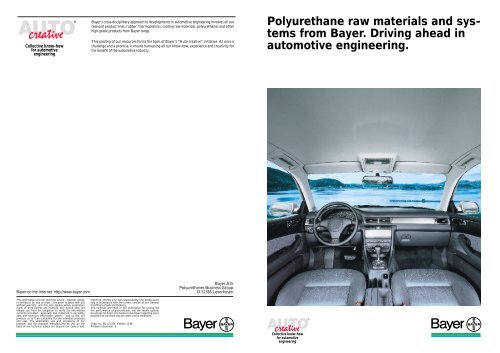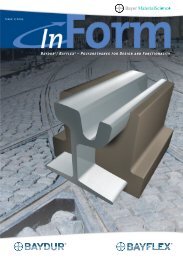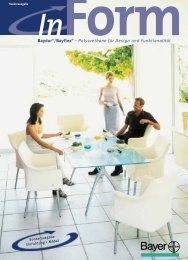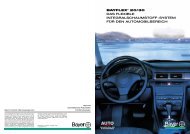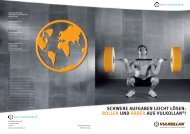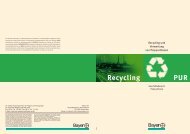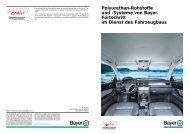Polyurethane raw materials and sys - PUR-Internet - Bayer
Polyurethane raw materials and sys - PUR-Internet - Bayer
Polyurethane raw materials and sys - PUR-Internet - Bayer
Create successful ePaper yourself
Turn your PDF publications into a flip-book with our unique Google optimized e-Paper software.
Collective know-how<br />
for automotive<br />
engineering<br />
<strong>Bayer</strong> AG<br />
<strong>Polyurethane</strong>s Business Group<br />
<strong>Bayer</strong> on the <strong>Internet</strong>: http://www.bayer.com D-51368 Leverkusen<br />
This information <strong>and</strong> our technical advice – whether verbal‚<br />
in writing or by way of trials – are given in good faith but<br />
without warranty‚ <strong>and</strong> this also applies where proprietary<br />
rights of third parties are involved. Our advice does not<br />
release you from the obligation to verify the information<br />
currently provided – especially that contained in our safety<br />
data <strong>and</strong> technical information sheets – <strong>and</strong> to test our<br />
products as to their suitability for the intended processes<br />
<strong>and</strong> uses. The application‚ use <strong>and</strong> processing of our<br />
products <strong>and</strong> the products manufactured by you on the<br />
basis of our technical advice are beyond our control <strong>and</strong>‚<br />
®<br />
<strong>Bayer</strong>’s cross-disciplinary approach to developments in automotive engineering involves all our<br />
relevant product lines: rubber, thermoplastics, coating <strong>raw</strong> <strong>materials</strong>, polyurethanes <strong>and</strong> other<br />
high-grade products from <strong>Bayer</strong> range.<br />
This pooling of our resources forms the basis of <strong>Bayer</strong>’s “Auto creative“ initiative. At once a<br />
challenge <strong>and</strong> a promise, it means harnessing all our know-how, experience <strong>and</strong> creativity for<br />
the benefit of the automotive industry.<br />
therefore‚ entirely your own responsibility. Our products are<br />
sold in accordance with the current version of our General<br />
Conditions of Sale <strong>and</strong> Delivery.<br />
The methods described in this publication for testing the<br />
fire performance of polyurethane‚ <strong>and</strong> the results quoted‚<br />
do not permit direct conclusions to be d<strong>raw</strong>n regarding every<br />
possible fire risk there may be under service conditions.<br />
Order no.: PU 52 220e · Edition: 10.98<br />
Printed in Germany · E<br />
<strong>Polyurethane</strong> <strong>raw</strong> <strong>materials</strong> <strong>and</strong> <strong>sys</strong>tems<br />
from <strong>Bayer</strong>. Driving ahead in<br />
automotive engineering.<br />
Collective know-how<br />
for automotive<br />
engineering<br />
®
<strong>Polyurethane</strong> - the material for<br />
automotive engineering<br />
With an annual worldwide consumption of<br />
approx. 1 million tonnes, polyurethane is one of<br />
the most widely used groups of plastics in automotive<br />
engineering. An average of approx. 18 kg is<br />
used in each vehicle, with up-market models containing<br />
even greater amounts. <strong>Polyurethane</strong>s are not just<br />
commodity plastics. They are manufactured from<br />
polyurethane <strong>raw</strong> <strong>materials</strong> <strong>and</strong> <strong>sys</strong>tems, from which<br />
the processors themselves produce tailor-made<br />
articles to meet their individual requirements.<br />
The increasing number of polyurethane applications<br />
in cars can be attributed to their special combination<br />
of product properties:<br />
� Low-cost component manufacturing <strong>and</strong><br />
vehicle assembly<br />
� Excellent long-term performance characteristics<br />
coupled with light weight<br />
� Improved comfort <strong>and</strong> model differentiation<br />
� Increased safety reserves in the event of accidents<br />
� Resource conservation through lightweight construction<br />
<strong>and</strong> recycling<br />
<strong>Bayer</strong> –<br />
a dependable<br />
partner worldwide<br />
Today, <strong>Bayer</strong> is the world's largest<br />
supplier of polyurethane<br />
<strong>raw</strong> <strong>materials</strong> <strong>and</strong> engineering<br />
polyurethanes for the automotive<br />
sector. <strong>Bayer</strong> is a dependable<br />
<strong>and</strong> resourceful partner in the<br />
supply of <strong>raw</strong> <strong>materials</strong> <strong>and</strong><br />
<strong>sys</strong>tems, the development of<br />
manufacturing technologies <strong>and</strong> the optimisation of<br />
components both for globally operating automotive<br />
companies <strong>and</strong> suppliers <strong>and</strong> for local, mid-sized<br />
companies. Development, marketing <strong>and</strong> production<br />
are located close to the local processors, but are linked<br />
to a global network.<br />
Worldwide polyurethane consumption in the automotive industry<br />
(Status: 1998)<br />
2 3<br />
1.200<br />
1.000<br />
800<br />
600<br />
400<br />
200<br />
0<br />
in Tausend 1,000 tonnes<br />
Tonnen<br />
Marketing centres with integrated technical service centre<br />
Technical Marketing centres service with integrated centres technical service centres<br />
Technical service centres<br />
Production sites sites including - incl. machinery processing <strong>and</strong> processing machinery technology from<strong>and</strong><br />
equipm<br />
of our our subsidiary affiliated Hennecke company GmbH Hennecke GmbH<br />
<strong>Bayer</strong> has marketing centres, technical service centres<br />
<strong>and</strong> production sites all over the world: in Europe,<br />
in the NAFTA region, in South America <strong>and</strong> the Far<br />
East. Nearness to the customer enables us to focus on<br />
local market needs.<br />
1990 91 92 93 94 95 96 97 98 99 2000 2001 2002 2003 2004 2005
<strong>Polyurethane</strong> <strong>raw</strong> <strong>materials</strong> <strong>and</strong><br />
<strong>sys</strong>tems from <strong>Bayer</strong>:<br />
Driving ahead in automotive<br />
engineering<br />
Changing dem<strong>and</strong>s made on the car <strong>and</strong> increased<br />
responsibility towards the consumer <strong>and</strong> the environment<br />
represent great challenges for the automotive<br />
sector in terms of:<br />
� Safety<br />
� Environmental compatibility<br />
� Low-cost manufacturing<br />
� Model differentiation<br />
� Comfort<br />
4 5<br />
Active <strong>and</strong> passive vehicle safety<br />
The use of polyurethanes reduces the risk of accidents:<br />
� Less driver fatigue<br />
Comfortable seat cushions made of Bayfit ® HC <strong>and</strong><br />
HR, sound insulation with foam-backed carpeting<br />
made of Bayfit ® SA.<br />
� Improvement of critical crash<br />
areas in the vehicle interior<br />
Padded steering wheels made of<br />
Bayflex ® 20/30, head restraints made of<br />
Bayfit ® , crash pads made of Bayfill ® EA in<br />
instrument panels <strong>and</strong> doors.<br />
� Flexible body panelling to prevent<br />
minor damage<br />
Bumper covers, rocker panels, wings <strong>and</strong> side<br />
panels in Bayflex ® ; energy-absorbing foam<br />
made of Bayfill ® EA in bumpers.<br />
Environmental compatibility<br />
The entire life cycle of the components must be taken<br />
into account when assessing their environmental<br />
compatibility. <strong>Polyurethane</strong>s help to improve this<br />
aspect through:<br />
� Continuous weight reduction of components <strong>and</strong><br />
assemblies. Lightweight design conserves <strong>raw</strong><br />
material resources <strong>and</strong> reduces fuel consumption<br />
<strong>and</strong> emissions.<br />
� Long service life of polyurethane components.<br />
� Recycling of used parts via material recycling or<br />
via incineration with energy recovery, always<br />
taking into account ecological <strong>and</strong> economic factors.
Low-cost vehicle manufacturing<br />
Manufacturing costs include all steps up to<br />
the final assembly of the component units in<br />
the vehicle. <strong>Polyurethane</strong> helps to integrate<br />
components, combine manufacturing steps<br />
<strong>and</strong> simplify vehicle design work, e.g.<br />
� Dual hardness seat cushions with anchoring<br />
elements produced in one manufacturing<br />
step<br />
� Foam-backed carpeting<br />
� Padded instrument panels<br />
� Bumpers: ready-to-install energy-absorbing<br />
foam mouldings complete with cover<br />
<strong>and</strong> mountings<br />
� Ready-to-install self-supporting headliners<br />
� Helper springs made of Vulkollan ®<br />
<strong>Polyurethane</strong> either as a foam or as a highstrength<br />
composite material reinforced with<br />
glass fibres, for example, offers enormous<br />
advantages for lightweight construction <strong>and</strong><br />
parts consolidation.<br />
6<br />
Car model differentiation<br />
While car manufacturers strive for a limited<br />
number of car types on the one h<strong>and</strong>, they<br />
also want to increase the attractiveness of<br />
their ranges by offering a wide variety of<br />
models on the other.<br />
<strong>Polyurethane</strong> components, in particular, enable<br />
large model series to be differentiated,<br />
<strong>and</strong> small series to be realised at a reasonable<br />
expense.<br />
Face-lifts for model updates <strong>and</strong> special<br />
series are effective marketing instruments<br />
<strong>and</strong> can be realised quickly <strong>and</strong> inexpensively<br />
with polyurethane mouldings.<br />
Comfort for the occupants<br />
<strong>Polyurethane</strong> components in the form of<br />
padding, attractively designed components<br />
which are soft to the touch <strong>and</strong> sound insulation<br />
all substantially improve vehicle comfort.<br />
This is why a large volume of polyurethane<br />
is used in mid-sized <strong>and</strong> top-of-therange<br />
cars. Compact <strong>and</strong> sub-compact cars<br />
are following this trend.<br />
<strong>Polyurethane</strong> <strong>sys</strong>tems from <strong>Bayer</strong><br />
Applications<br />
Seats, backrests<br />
Headrests<br />
Two-wheel vehicle saddles<br />
Steering wheels<br />
Instrument panels, trim<br />
Seat <strong>and</strong> backrest shells, engine shrouds<br />
Spare-wheel covers, roof elements<br />
Headliners<br />
Sun visors<br />
Sound absorption elements, e.g. foam-backed carpeting<br />
Energy-absorbing padding<br />
Foam filling of cavities<br />
Front <strong>and</strong> rear bumpers<br />
Rocker panels, side mouldings, panels, wings<br />
Modular window encapsulation<br />
Spoilers, wind deflectors<br />
Elastic components<br />
Helper springs<br />
Gaskets, filters<br />
Range of properties<br />
Flexible<br />
Semi-rigid<br />
Rigid<br />
Elastic<br />
Foamed<br />
Microcellular<br />
Integral skin foam<br />
Solid<br />
Fibre reinforcement or mineral filling<br />
Our platform:<br />
� High product quality<br />
� Expertise in <strong>materials</strong><br />
� Process engineering<br />
know-how<br />
Bayfit ® HR/HC<br />
Our advantages:<br />
� Nearness to the customer<br />
� Individually tailored concepts<br />
� Service<br />
7<br />
Bayfit ® SA<br />
Slab foam<br />
Rebonded foam<br />
Bayfill ®<br />
Bayfill ® EA<br />
Bayflex ® integral skin foam<br />
Bayflex ® RIM/RRIM<br />
Baydur ®<br />
Baydur ® STR/Baypreg ®<br />
Baynat ®<br />
Urepan ®<br />
Baytec ®<br />
Vulkollan ®<br />
� Innovative research <strong>and</strong><br />
development work<br />
� Cooperation with experts from the<br />
automotive <strong>and</strong> automotive supply<br />
industries
Bayfit ® : comfortable<br />
<strong>and</strong> safe<br />
seats<br />
Great dem<strong>and</strong>s are<br />
placed on good car<br />
seats. Criteria such as<br />
climatic comfort <strong>and</strong><br />
driving safety are<br />
decisive, in addition<br />
to ergonomic<br />
seat design, good<br />
vibration damping <strong>and</strong><br />
long-term performance characteristics.<br />
These dem<strong>and</strong>s are<br />
ideally met by seat <strong>and</strong> backrest<br />
cushions made of Bayfit ® .<br />
Properties of various Bayfit ® foams<br />
Density<br />
DIN 53420 (kg/m3) Compressive strength 40%<br />
DIN 53577 (kPa)<br />
Compression set 50%, 70 °C, 22 h<br />
DIN 53572 (%)<br />
Elongation at break<br />
DIN 53571 (%)<br />
Tensile strength<br />
DIN 53571 (kPa)<br />
Tear resistance<br />
ASTM-D 3574-91 (N/m)<br />
8 9<br />
This flexible polyurethane moulded foam is:<br />
� High load bearing <strong>and</strong> permanently elastic<br />
� Capable of being manufactured in virtually any shape<br />
� Easy to manufacture in series production (inserts<br />
for mounting the upholstery can be directly<br />
moulded in)<br />
� Capable of being manufactured with increased<br />
lateral stability (dual-hardness technology)<br />
Depending on the production process, a distinction is<br />
made between the hot-curing moulded foam Bayfit ® HC<br />
<strong>and</strong> the cold-curing moulded foams Bayfit ® HR-T<br />
(based on TDI) <strong>and</strong> HR-M (based on MDI).<br />
HC HR-T HR-M<br />
30–40 38–48 45–60<br />
3–7 2–8 4–12<br />
2–4 4–8 4–8<br />
120 – 160 100 – 150 90 – 140<br />
80 – 140 130 – 200 100 – 160<br />
200 – 400 200 – 450 160 – 250
10 11<br />
Bayfit ® SA: custom-tailored<br />
sound insulation<br />
The acoustic properties of motor vehicles are taking<br />
on increasing importance. In response to more stringent<br />
noise legislation <strong>and</strong> growing dem<strong>and</strong>s for comfort<br />
from motorists, both top-of-the-range models <strong>and</strong><br />
smaller, compact cars are being fitted with sound<br />
absorption in the engine compartment <strong>and</strong> passenger<br />
saloon.<br />
Noise reduction techniques include:<br />
� Foam-backed carpeting<br />
� Bulkhead cladding<br />
� Sound deadening engine shrouds<br />
The Bayfit ® SA range of <strong>sys</strong>tems provides the perfect<br />
answer to these <strong>and</strong> other requirements. In the case of<br />
both air-borne <strong>and</strong> solid-borne noise, Bayfit ® SA<br />
foams satisfy the most dem<strong>and</strong>ing acoustic requirements.<br />
At the same time they provide the necessary<br />
long-term performance properties <strong>and</strong> resistance to<br />
high mechanical loads <strong>and</strong> climatic extremes.<br />
Bayfit ® SA is available in grades ranging from high<br />
resilient through st<strong>and</strong>ard <strong>and</strong> viscoelastic to<br />
adhesive.<br />
Properties of various Bayfit ® SA foams<br />
HR St<strong>and</strong>ard Visco- Adhesive<br />
elastic<br />
Density<br />
DIN 53420 (kg/m<br />
45 – 65 50–70 50 – 70 60 – 80<br />
3)<br />
Compression hardness 40%<br />
4–7<br />
DIN 53577 (kPa)<br />
5–15 3 – 10 3 – 10<br />
Compression set 50%<br />
DIN 53572 (%)<br />
5 – 15 5 – 15 7 – 15 10 – 20<br />
Loss factor �<br />
< 0,2 0,2 – 0,3<br />
Oscillation-damping method<br />
0,3 – 0,5 > 0,5
12<br />
Baynat ® : accurately fitting,<br />
self-supporting, ready-toinstall<br />
lightweight<br />
headliners<br />
Baynat ® is a specialised rigid foam<br />
in sheet form which is compression<br />
moulded into s<strong>and</strong>wiched headliners<br />
in combination with fibrous facings<br />
<strong>and</strong> decorative <strong>materials</strong>.<br />
Baynat headliners are:<br />
� Lightweight<br />
� Self-supporting, even under the effects of heat<br />
� Dimensionally stable<br />
� Noise-absorbing<br />
� Buckle- <strong>and</strong> rupture-resistant during installation.<br />
Baynat ® slab foam<br />
Baynat ® DTB* panels<br />
Slab foam DTB * panels<br />
Applications for simple for complex for semi-complex <strong>and</strong><br />
shapes shapes complex shapes<br />
Density<br />
DIN 53420 (kg/m<br />
20–25 30–35 39–43<br />
3 )<br />
Compressive strength<br />
0,09 – 0,14 0,13 – 0,20 0,15** N/mm2 DIN 53421 (MPa)<br />
Flexural strength<br />
0,12 – 0,18 0,26 – 0,35 1,95* N/mm2 DIN 53423 (MPa)<br />
Strain in outer fibres<br />
DIN 53423 (%)<br />
19–26 23–24 —<br />
Sheet thickness<br />
with facings (mm)<br />
— — 6,0*<br />
* Measured on s<strong>and</strong>wich panels at 10 % deformation<br />
** S<strong>and</strong>wich panels produced on a continuous laminator<br />
13
Baydur ® STR: lightweight<br />
mouldings for interior <strong>and</strong><br />
exterior applications<br />
Baydur ® STR is a tough, rigid polyurethane in foamed<br />
or solid form which is produced in moulds in combination<br />
with milled fibres or fibre mats. Various reinforcing<br />
<strong>materials</strong> can be combined to form composites,<br />
<strong>and</strong> anchoring elements, hinges <strong>and</strong> even pressure-sensitive<br />
decorative facings can be integrated in a<br />
single operation. This gives a wide range of application<br />
options <strong>and</strong> has major advantages for economical<br />
production through the integration of structural elements<br />
<strong>and</strong> the reduction of manufacturing steps.<br />
The mouldings offer:<br />
� Very good mechanical strength with low weight<br />
� Dimensional stability<br />
� Low water absorption.<br />
14 15<br />
Baydur ® STR<br />
Applications Trim panels Instrument<br />
panel supports<br />
Density<br />
DIN 53420 (kg/m3 )<br />
Typical applications include:<br />
� Instrument panel supports<br />
� Consoles <strong>and</strong> door panels<br />
� Roof panels <strong>and</strong> seat trim<br />
� Spoilers<br />
� Seat shells <strong>and</strong> backrests<br />
� Spare-wheel wells <strong>and</strong> covers<br />
� Luggage compartment floors<br />
� Engine shrouds<br />
500 1.000<br />
Weight per unit area of glass mat 300 600<br />
(g/m 2 )<br />
Specimen thickness<br />
(mm)<br />
Flexural modulus<br />
DIN 53423 (MPa)<br />
Flexural strength<br />
DIN 53423 (MPa)<br />
Impact resistance<br />
DIN 53453 (kJ/m2 )<br />
Elongation at break<br />
DIN 53455 (%)<br />
Heat deflection temperature,<br />
B test, DIN 53461 (˚C)<br />
4 3<br />
1.100 3.600<br />
30 95<br />
18 40<br />
2,1 2,2<br />
140 200
Baypreg ® F: in good shape<br />
Baypreg ® F is a special 2-component polyurethane<br />
material for the production of fibre-reinforced automotive<br />
interior fittings by compression moulding.<br />
Baypreg ® F can be combined with natural fibres like<br />
flax <strong>and</strong> sisal to produce thin-section trim panelling<br />
with a low unit area weight.<br />
S<strong>and</strong>wich structures consisting of Baypreg ® F with<br />
paper honeycombs or glass fibre mats are used to<br />
manufacture sliding roofs <strong>and</strong> inlay mats for car<br />
boots.<br />
Mouldings made from Baypreg ® F in combination<br />
with other <strong>materials</strong> feature:<br />
� Very good mechanical properties coupled with<br />
light weight<br />
� Very good dimensional stability<br />
� A low coefficient of linear expansion<br />
� When the product reaches the end of its service<br />
life, parts reinforced with natural fibres can be<br />
thermally recycled, with all the CO2 bound in the<br />
vegetable fibres being returned to the environment.<br />
16 17<br />
Baypreg ® F<br />
Typical Door trim Inlay<br />
applications supports mats<br />
Density<br />
DIN 53420 (kg/m3 )<br />
— —<br />
Fibre mat Flax/sisal 50:50 Glass mat<br />
Paper honeycomb — 5/5<br />
Weight per unit area<br />
of mat (g/m2 )<br />
Weight per unit area<br />
of part (g/m2 )<br />
<strong>Polyurethane</strong> content<br />
of final product (%)<br />
900 450<br />
1.400 3.600<br />
45 50<br />
Specimen thickness (mm) 1,8 10<br />
Flexural modulus<br />
DIN 53423 (MPa)<br />
Flexural strength<br />
DIN 53423 (MPa)<br />
Impact resistance<br />
DIN 53453 (kJ/m2 )<br />
3.500 3.500<br />
20 30<br />
15 15<br />
Moisture content (%) 2,5 —<br />
Coefficient of linear expansion
18<br />
Bayfill ® : comfort <strong>and</strong> safety in<br />
the interior<br />
Padded instrument panels <strong>and</strong> interior trim add to the<br />
comfort <strong>and</strong> safety of the occupants.<br />
The components are pleasant to the touch, make for a<br />
cosy atmosphere <strong>and</strong> contribute to reducing noise.<br />
Driver tension is eased, making driving safer.<br />
Coupled with cost effectiveness for users in the<br />
automotive industry, these are key aspects of Bayfill ®<br />
semi-rigid polyurethane filling foam.<br />
19<br />
Mechanical properties of Bayfill ®<br />
<strong>sys</strong>tems<br />
Bayfill ® –System<br />
Density<br />
DIN 53420 (kg/m3 )<br />
Tensile strength<br />
DIN 53571 (kPa)<br />
Elongation at break<br />
DIN 53571 (%)<br />
Compression hardness at 40%<br />
DIN 53577 (kPa)<br />
Fogging<br />
DIN 75201 B (mg)<br />
Manufacturing process<br />
High Low<br />
density density<br />
200-230 150-170<br />
300 300<br />
40 40<br />
75 75<br />
1,0 0,2<br />
Parts are manufactured by inserting a<br />
xxpreformed decorative material <strong>and</strong><br />
a support into a mould <strong>and</strong> foammoulding<br />
a firm, durable<br />
composite structure with<br />
Bayfill ® as the lightweight<br />
padding material. The process<br />
also allows economical production of<br />
complex contours.
20 21<br />
Bayfill ® EA in safety components<br />
for impact absorption<br />
Energy-absorbing elements such as knee, pelvis <strong>and</strong><br />
head bolsters, which undergo permanent deformation,<br />
are used in vehicle interiors to protect the occupants<br />
in the event of a collision.<br />
On the exterior, bumpers are provided with an energy-absorbing,<br />
reversibly deformable foam core.<br />
Designing integrated protection for pedestrians into<br />
the front of the vehicle is also simpler using<br />
Bayfill ®<br />
EA foam.<br />
Bayfill ® EA<br />
Applications Bumpers Pelvic Thoracic Head<br />
bolsters bolsters bolsters<br />
Density<br />
DIN 53420 (kg/m3 )<br />
55–80 45–80 45–60 80–150<br />
Compression hardness 40% 125 – 330200 – 700 70 – 150 700 – 2000<br />
DIN 53577 (kPa)<br />
Compression set 50 °C, 22 h
Bayflex ® RIM<br />
for exterior body parts<br />
Bayflex ® RIM is a moulded micro-cellular or solid<br />
polyurethane material usually reinforced with fillers.<br />
It is used for painted body parts, such as:<br />
� Bumper covers � Spoilers<br />
� Side panels � Wings<br />
� Rocker panels � Door panels<br />
22 23<br />
The material permits complex shapes with long flow<br />
paths. New component designs provide for wall<br />
thicknesses of 1.5 to 2.5 mm. Bayflex ® RIM st<strong>and</strong>s<br />
out from other plastics due to its special combination<br />
of properties:<br />
� Light weight<br />
� Rigid but elastic<br />
� Impact resistance at low temperatures<br />
� Low coefficient of thermal expansion<br />
� Dimensional stability at relatively high coating<br />
temperatures<br />
Bayflex ® for modular window<br />
encapsulation<br />
Paintable or light-resistant Bayflex ® is used to encapsulate<br />
windows <strong>and</strong> sun roofs. Due to its excellent flowablility<br />
<strong>and</strong> low processing pressures as compared<br />
with injection moulding, the material is particularly<br />
suitable for large, curved windows.<br />
Bayflex<br />
Modular window encapsulation<br />
Applications Valance<br />
panels<br />
Rocker panels<br />
side mouldings<br />
wings<br />
weather<br />
stabilised<br />
formulation<br />
weather<br />
stabilised by<br />
in-mould coating<br />
® 180 Bayflex ® 190 Bayflex ® Bayflex ®<br />
WR 40-6 MP 10.000<br />
Wings<br />
on line paintable<br />
to 190 ∞C<br />
Wollastonite<br />
in the elastomer (%)<br />
KMilled fibre MF 7980<br />
in the elastomer (%)<br />
— — 20–25 — —<br />
17 24 — — —<br />
Density DIN 53420 (g/m 3 ) 1,20 1,25 1,25 – 1,30 1,00 1,00<br />
Shore A hardness DIN 53505 — — — 85 A 36 D<br />
Tensile strength<br />
DIN 53504 (MPa)<br />
Elongation at break<br />
DIN 53504 (%)<br />
Flexural modulus<br />
DIN 53457 (MPa)<br />
Sag 1 h/ 160 ∞C/100 mm<br />
overhang (mm)<br />
Low temperature impact strength<br />
Dynstat (-30 ∞C) DIN 53435 (kJ/m2 Tear propagation strength<br />
DIN 53515 (kN/m)<br />
)<br />
25 25 25 15 18<br />
>130 >80 30 – 50 >230 >280<br />
— — — 22 33<br />
1.200 1.600 1.700 – 2.000 — —<br />
4 2 1 — —<br />
>20 >15 ≥10 — —<br />
Coefficient of linear thermal<br />
expansion II<br />
DIN 53752 (10<br />
55 – 65 40 – 50 ≥33 — —<br />
-6 m/m K)<br />
Recommended moulded<br />
wall thickness (mm)<br />
≥2,2 * ≥1,8 ≥2,5 — —<br />
* ( 1.5 mm, back-filled with EA foam in direction of fibres
Steering wheels made of<br />
Bayflex ® 20/30 integral skin<br />
foam<br />
Integral skin foam articles with a wear-resistant,<br />
compacted or solid outer skin <strong>and</strong> a<br />
soft, flexible, cellular core are moulded<br />
in one step. HCFCs, pentane or CO2<br />
have now replaced CFCs as blowing<br />
agents.<br />
Overall density of test sheets<br />
(kg/m3 )<br />
Cellular core<br />
Density<br />
DIN 53420 (kg/m3 )<br />
Tensile strength<br />
DIN 53571 (kPa)<br />
Elongation at break<br />
DIN 53571 (%)<br />
Compression hardness 40%<br />
DIN 53577 (kPa)<br />
Compression set 50 %, 70 °C, 22 h<br />
DIN 53572 (%)<br />
Skin zone<br />
Tensile strength<br />
DIN 53571 (kPa)<br />
Elongation at break<br />
DIN 53571 (%)<br />
Tear propagation strength<br />
DIN 53575 (kN/m)<br />
24 25<br />
Attractive, grained surfaces can be produced in accurate<br />
detail. The articles can be coated for protection<br />
against weathering <strong>and</strong> wear, or to lend colour.<br />
Steering wheels all over the world are predominantly<br />
manufactured using integral skin polyurethane foam.<br />
If water is used as the blowing agent, the articles<br />
must be painted.<br />
Other applications include:<br />
� Two-wheel vehicle saddles � Gear lever knobs<br />
� Grab h<strong>and</strong>les � Spoilers<br />
� Protective mouldings � Head restraints<br />
� Armrests<br />
Bayflex ® 20/30<br />
Type A Type B<br />
Blowing agent R 134a CO2<br />
400 400<br />
380 – 400 380 – 400<br />
1.100 – 1.400 1.200 – 1.600<br />
80 – 120 70 – 110<br />
300 – 360 330 – 400<br />
26 27<br />
Vulkollan ® polyurethane elastomers:<br />
flexibility for innovative<br />
design ideas<br />
New <strong>materials</strong> often provide a springboard for innovative<br />
designs. A good example of this is Vulkollan<br />
from <strong>Bayer</strong>, which opens the door to innovative<br />
designs in the chassis <strong>and</strong> the steering <strong>sys</strong>tem.<br />
Manufacturing method:<br />
� Casting<br />
<strong>Polyurethane</strong> elastomers based on Desmodur ® 15<br />
<strong>and</strong> polyester have the following characteristics:<br />
� Resistance to oil <strong>and</strong> grease<br />
� Wear resistance<br />
� Elasticity<br />
� Flexibility over a wide temperature range<br />
� Ease of assembly<br />
� Freedom from maintenance<br />
� Lightweight <strong>and</strong> space-saving<br />
� Resistance to dynamic loads<br />
� Scope for innovative design<br />
<strong>Polyurethane</strong> elastomers have proved to be particularly<br />
effective in:<br />
� Damping <strong>and</strong> spring elements<br />
� Gaskets<br />
� Step bearings<br />
� Bearing bushings<br />
Progressive helper springs made of cellular<br />
Vulkollan ® are widely used today in modern suspension<br />
strut designs.
Recycling <strong>and</strong><br />
reuse<br />
All polyurethane <strong>materials</strong> can be reused, either<br />
by mechanical or chemical recycling or by thermal<br />
treatment with recovery of the energy content.<br />
The main processes are:<br />
� Comminution of large quantities of foam remnants<br />
into foam flocks which are then processed into<br />
rebonded foam articles, e. g. carpet backings,<br />
sound insulators, insulating mats.<br />
� <strong>Polyurethane</strong>s can be finely ground <strong>and</strong> added to<br />
one of the <strong>raw</strong> material components as a filler. This<br />
also makes recycling in the original application<br />
possible, e. g. in moulded foam for seat cushions<br />
<strong>and</strong> - in the case of RIM technology - in body<br />
parts.<br />
� Comminuted <strong>and</strong> ground polyurethanes are mixed<br />
with polyurethane binders <strong>and</strong> compression moulded<br />
or cast in moulds, for example, rear-window<br />
shelves or workbench tops.<br />
28 29<br />
� Another recycling technique is glycolysis - the<br />
liquefaction of polyurethanes with glycols. The<br />
resultant recyclate polyols are mainly processed<br />
into rigid foam <strong>and</strong> structural<br />
components reinforced with<br />
glass fibre mats (Baydur ®<br />
STR).<br />
� The techniques<br />
of pyrolysis,hydrogenation<br />
<strong>and</strong><br />
synthesis gas<br />
production yield <strong>raw</strong><br />
<strong>materials</strong> for the petrochemical<br />
industry.<br />
� <strong>Polyurethane</strong> waste can be used as a reducing<br />
agent in the smelting of iron ore.<br />
� Incineration with energy recovery. The exhaust gas<br />
emissions from the thermal recycling of polyurethanes<br />
in modern plants have been shown to be safe<br />
<strong>and</strong> within the statutory tolerance limits.<br />
Ecological <strong>and</strong> economic factors determine the choice<br />
of material recycling process or incineration with<br />
energy recovery. The method <strong>and</strong> scope of disassembly<br />
of the plastic components must be geared to the<br />
recycling processes used <strong>and</strong> the available marketing<br />
options.<br />
Even if mechanical <strong>and</strong> chemical recycling (e.g. glycolysis)<br />
are used extensively, it will still be necessary<br />
to dispose of some of the plastics at the end of their<br />
useful life. Ultimately, petrochemical feedstock<br />
recovery or incineration with recovery of the energy<br />
content are the only methods capable of easing the<br />
burden on available l<strong>and</strong>fill space.
Lending a helping h<strong>and</strong><br />
The future of automotive engineering lies in individual<br />
design solutions which ensure maximum cost<br />
effectiveness.<br />
30<br />
The versatility of high-quality polyurethane <strong>raw</strong> <strong>materials</strong><br />
<strong>and</strong> <strong>sys</strong>tems from <strong>Bayer</strong>, our experience in polyurethane<br />
chemistry <strong>and</strong> <strong>Bayer</strong>'s broad range of services<br />
<strong>and</strong> global resources provide our customers <strong>and</strong> processors<br />
with the tools they need to master this challenge.<br />
Are you a designer, design engineer or someone involved with<br />
the problems of the automotive <strong>and</strong> automotive supply industry?<br />
We can help you. Just get in touch with us - anywhere in the world!<br />
31


